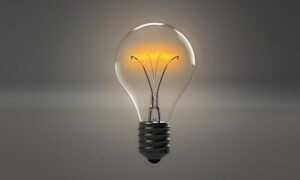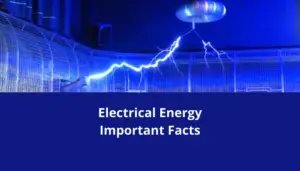Table of Contents
what is electrical energy?
Electrical energy is a form of energy resulting from the movement of electric charges (electrons) through a conductor, such as a wire. It is one of the most versatile and widely used forms of energy in modern life, enabling the operation of countless devices and systems.
Key Characteristics of Electrical Energy:
- Nature: It arises from the presence and motion of charged particles, primarily electrons.
- Types:
- Static Electricity: Caused by the accumulation of charges on a surface, leading to potential energy.
- Dynamic Electricity (Electric Current): Flow of electric charges through a conductor, usually driven by a voltage source.
- Forms of Current:
- Direct Current (DC): Charges flow in a single direction.
- Alternating Current (AC): Charges periodically reverse direction.
Sources of Electrical Energy:
- Natural Sources: Lightning, static discharge.
- Generated Sources: Power plants that convert other forms of energy (mechanical, chemical, or thermal) into electricity using methods like:
- Coal, natural gas, or nuclear power plants.
- Renewable sources like solar panels, wind turbines, and hydroelectric dams.
Measurement:
Electrical energy is typically measured in kilowatt-hours (kWh), which represents the amount of energy consumed when a device uses 1 kilowatt of power for 1 hour.
For more information about AC Generator, Read my detailed article here.
Applications Of Electrical Energy
Electrical energy has a broad range of applications in nearly every aspect of modern life. Below is a categorized overview of its uses:
Residential Applications
- Lighting: Powering LED, CFL, and incandescent bulbs to illuminate homes.
- Appliances: Operating devices like refrigerators, washing machines, ovens, microwaves, and vacuum cleaners.
- Climate Control: Running air conditioners, heaters, and fans.
- Entertainment: Powering TVs, gaming consoles, and sound systems.
- Charging Devices: Providing energy for charging smartphones, laptops, and other electronics.
Industrial Applications
- Machinery: Driving motors and industrial machines for manufacturing and production.
- Heating and Cooling: Operating furnaces, industrial freezers, and HVAC systems.
- Automation: Powering robots, conveyor belts, and control systems.
- Electrochemical Processes: Used in electrolysis, electroplating, and refining metals.
- Data Centers: Operating servers, cooling systems, and networks for IT and cloud services.
Commercial Applications
- Retail: Lighting, HVAC systems, and point-of-sale equipment in stores and malls.
- Offices: Powering computers, printers, and office equipment.
- Hospitality: Operating appliances, lighting, and climate control in hotels and restaurants.
Transportation
- Electric Vehicles (EVs): Powering cars, buses, and bikes through batteries or hybrid systems.
- Public Transit: Running electric trains, trams, and subways.
- Aviation: Used in some hybrid or fully electric aircraft.
- Maritime: Powering electric ferries and boats.
Healthcare
- Medical Equipment: Operating diagnostic devices like X-ray machines, MRI scanners, and ventilators.
- Life Support Systems: Powering incubators, dialysis machines, and monitors.
- Lighting and HVAC: Maintaining optimal environments in hospitals and clinics.
Communication and Technology
- Telecommunication: Powering cell towers, satellites, and communication networks.
- Computing: Supporting servers, personal computers, and mobile devices.
- Media: Running broadcast equipment for TV and radio.
Public Infrastructure
- Street Lighting: Illuminating roads and public spaces.
- Water Supply: Running pumps and treatment plants.
- Traffic Management: Powering traffic lights and electronic signage.
Renewable Energy Systems
- Energy Storage: Charging batteries for solar and wind energy storage systems.
- Grid Systems: Supporting smart grids for efficient energy distribution.
Agriculture
- Irrigation Systems: Operating electric pumps and sprinklers.
- Processing: Powering machinery for food processing and packaging.
- Climate Control: Running fans and heaters in greenhouses.
Scientific Research
- Laboratory Equipment: Powering advanced tools like spectrometers and electron microscopes.
- Particle Accelerators: Driving high-energy physics experiments.
- Space Exploration: Supplying power for satellites, rovers, and spacecraft.
Electrical energy is fundamental to progress and innovation, enabling advancements across all sectors.
For more about electrical energy uses, read my other article here.

Can Electrical Energy Be Converted To Chemical Energy?
Yes, electrical energy can be converted into chemical energy. This conversion happens in various processes and devices, the most common being electrochemical reactions. Here are some examples:
Batteries (Charging Process)
- Rechargeable Batteries: When a battery is charged, electrical energy is converted into chemical energy and stored in the battery.
- Example: Lithium-ion, lead-acid, or nickel-metal hydride batteries.
- Mechanism: An external electrical source drives a chemical reaction that reverses the discharge process, restoring the battery’s energy storage capacity.
Electrolysis
- Water Splitting: Electrical energy is used to split water (H₂O) into hydrogen (H₂) and oxygen (O₂) gases.
- The hydrogen gas stores chemical energy that can be later used as fuel.
- Metal Refining and Plating: Electrical energy drives chemical reactions to deposit metals on surfaces or purify them.
Fuel Cells (Reverse Process)
- In some cases, fuel cells use electrical energy to produce fuel, storing energy in a chemical form, such as hydrogen.
Industrial Applications
- Chemical Manufacturing: Electrical energy is used to produce chemical compounds like chlorine, sodium hydroxide, and ammonia through electrochemical processes.
Photosynthesis (Artificial Methods)
- Researchers are developing technologies that mimic natural photosynthesis, using electrical energy to convert carbon dioxide (CO₂) and water into chemical fuels, such as methanol or hydrocarbons.
Practical Implications
Converting electrical energy to chemical energy is a cornerstone of modern energy systems, particularly in renewable energy storage, where excess electricity (e.g., from solar or wind) can be stored chemically for later use.
How is electrical energy converted into mechanical energy?
Electrical energy is converted into mechanical energy primarily through devices called electric motors. These motors operate based on the interaction between magnetic fields and electric currents.
In an electric motor:
- An electric current flows through a coil or conductor within a magnetic field.
- The interaction between the current and the magnetic field generates a force, following Lorentz’s force law.
- This force creates rotational or linear motion, depending on the motor’s design.
Applications of this conversion include powering fans, pumps, elevators, and various machinery in industries.
What forms of energy can be converted into electrical energy?
Several forms of energy can be converted into electrical energy, including:
-
Mechanical Energy:
- Converted using generators in power plants, wind turbines, and hydroelectric systems.
-
Chemical Energy:
- Transformed via batteries, fuel cells, and electrochemical processes.
-
Thermal Energy:
- Converted through thermoelectric generators, geothermal systems, and steam turbines in fossil fuel and nuclear power plants.
-
Solar Energy (Radiant Energy):
- Transformed using photovoltaic (solar) panels.
-
Nuclear Energy:
- Used to heat water and produce steam, which drives turbines connected to generators.
-
Electromagnetic Energy:
- Captured via antennas and used in applications like wireless power transmission and energy harvesting.
These conversions form the backbone of modern electricity generation and energy systems.
Does heat loss occur during the conversion of electrical energy into another form?
Yes, heat loss often occurs when electrical energy is converted into another form. This is due to inefficiencies in the energy conversion process. For example:
-
Electrical to Mechanical Energy (e.g., in motors):
- Some energy is lost as heat due to electrical resistance in the wires and components.
- Friction within moving parts also contributes to heat loss.
-
Electrical to Thermal Energy (e.g., in heaters):
- While the primary purpose is to produce heat, not all electrical energy is efficiently converted, and there may be losses to the surroundings.
-
Electrical to Light Energy (e.g., in light bulbs):
- Incandescent bulbs lose most of their energy as heat, while LED bulbs are more efficient but still experience minor heat loss.
-
Electrical to Chemical Energy (e.g., in batteries):
- During charging, resistance in the battery causes heat generation.
Heat loss is a natural outcome of the second law of thermodynamics, which states that energy conversion processes are never 100% efficient. This is why engineers focus on improving the efficiency of devices to minimize such losses.
Read my detailed article The Hidden Dangers of Electrical Cords Getting Too Hot
What Is the Difference Between Electrical Energy And Power?
The primary distinction between electrical energy and electrical power is that electrical energy refers to the amount of effort that must be done to initiate the flow of electric current across a circuit, whereas electrical power refers to the actual flow of electric current.
In contrast, the pace at which work—basically the movement of charges—is accomplished in an electrical circuit is the definition of electrical power. Additionally, the rate is determined by the unit of time that is being used.
Table Comparison of Electrical Energy and Electrical Power with Key Differences
|
Reference Points |
Electrical Energy | Electrical Power |
| Definition | Within the context of an electrical and electronic circuit, the capacity to carry out electric work is the definition of electrical energy. | Electrical power can be defined as the “rate of work done per unit charge” or the “rate of energy transfer per unit time.” Both of these phrases refer to the same thing. |
| By letter representation | With a W or E, electrical energy is indicated. | P represents the electrical power. |
| Formula | Energy: (W)= (Energy × Time) or(Work × Time) | Power: (P)= (Work ÷ Time) or (Energy ÷ Time) |
| S.I Unit | Kilowatt-hours are the SI unit of electrical energy measurement (kWh). | The Watt (W) or Joule/Sec (J/s) is the SI unit for electrical power. |
| Transform | It is easily convertible into another type of energy (like heat, light, etc.). | It cannot transform into another type of power. |
| Function 1 | You can produce or consume electrical energy. | Like energy, power cannot be produced. |
| Function 2 | The energy produced can be saved for later use.
The two finest types of energy storage devices are batteries and generators. |
The other storable items are unable to store electricity. |
Types of electrical energy
Electrical energy can be categorized based on its nature, source, or method of use. Below are the main types of electrical energy:
Static Electricity
- Definition: Energy stored due to the accumulation of electric charges on a surface.
- Characteristics: It does not flow; instead, it exists as potential energy until discharged.
- Example: Lightning, rubbing a balloon on hair.
Dynamic Electricity (Electric Current)
- Definition: Energy resulting from the flow of electric charges through a conductor.
- Subtypes:
- Direct Current (DC): Charges flow in one direction.
- Examples: Batteries, solar panels.
- Alternating Current (AC): Charges periodically reverse direction.
- Examples: Electricity supplied to homes and industries.
- Direct Current (DC): Charges flow in one direction.
Stored Electrical Energy
- Definition: Energy stored in an electrical form, ready to be released.
- Examples:
- Capacitors: Store electrical energy in an electric field.
- Batteries: Store electrical energy as chemical energy.
Electromagnetic Energy
- Definition: Electrical energy associated with electromagnetic waves.
- Examples:
- Radio waves, microwaves, and X-rays in communication and medical equipment.
Renewable Electrical Energy
- Definition: Electricity generated from renewable resources.
- Examples:
- Solar energy (photovoltaic cells).
- Wind energy (turbines).
- Hydroelectric energy (water flow).
Non-Renewable Electrical Energy
- Definition: Electricity generated from finite resources.
- Examples:
- Fossil fuels (coal, oil, natural gas).
- Nuclear energy.
Thermal Electrical Energy
- Definition: Electricity produced by converting heat into electrical energy.
- Examples:
- Thermoelectric generators.
- Geothermal energy systems.
These categories highlight the diverse ways electrical energy can exist and be utilized, making it one of the most versatile energy forms.
Don’t Leave Empty-Handed!
Install my Free Android App on Google Play:
Electrical Cables Most Common Tables “Cables Tables”
And, my Electrical Calculations App “Fast Electrical Calculator”
Discover more great content by subscribing to My channel
Looking to stay ahead of the game in the world of electrical engineering? Subscribe to my YouTube channel and gain access to exclusive content you won’t find anywhere else!
The staff I recommend
(Amazon Affiliate Links to products I believe are high quality):
- Economy 120 Volt/60Hz AC Power Source – Step-Down Voltage & Frequency Converters 1800W
- UNI-T Digital Multimeter Tester UT139C
- 50-Amp Extension Cord for RV “100ft”
- Voltage Stabilizer 110/220v
- Hair Dryer “best selling“
- TOSHIBA EM131A5C-BS Countertop Microwave Ovens
Disclaimer: This contains affiliate links to Amazon products. I may earn a commission for purchases made through these links.


